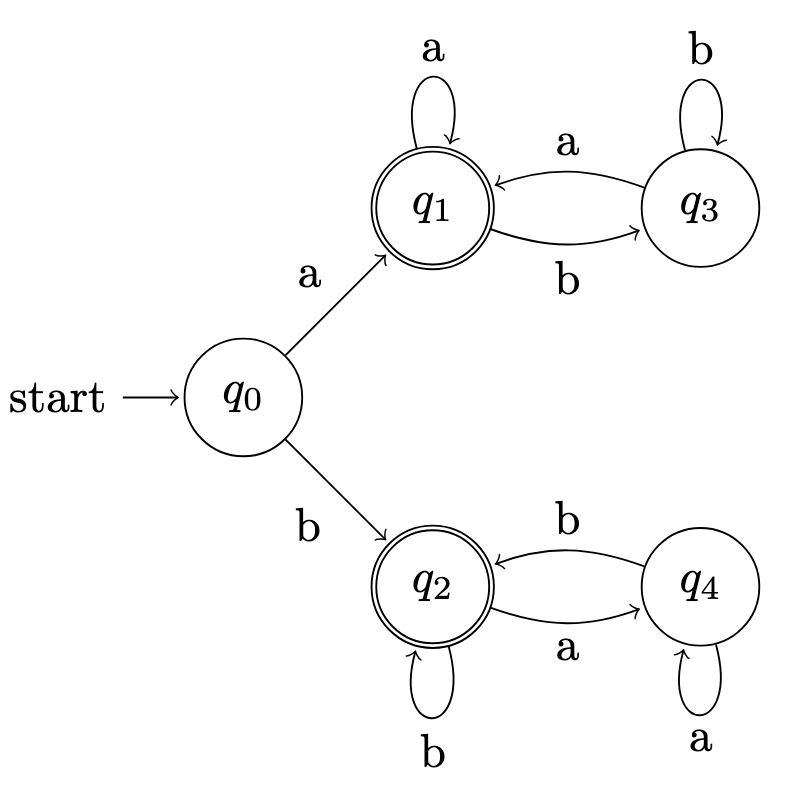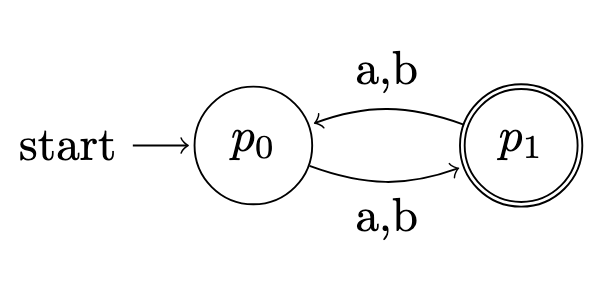Assignment 2 (Regular Expressions, Automata, Conversions)
- Consider the following languages over alphabet { a, b }:
L1 = set of words that start and end with the same symbol
L2 = set of words of odd length
The DFAs for L1 and L2 are shown below:


Construct DFAs for the following languages:
- L1 ∪ L2

- L1 . L2

e-closure of states:
q0 {'q0'} q1 {'p0', 'q1'} q2 {'p0', 'q2'} q3 {'q3'} q4 {'q4'} p0 {'p0'} p1 {'p1'}Applying RMET, we get the following NFA without empty transitions:
start q0 final p1 trans q0:a:q1 trans q0:a:p0 trans q0:b:p0 trans q0:b:q2 trans q1:a:p1 trans q1:a:q1 trans q1:a:p0 trans q1:b:p1 trans q1:b:q3 trans q2:a:p1 trans q2:a:q4 trans q2:b:p1 trans q2:b:p0 trans q2:b:q2 trans q3:a:q1 trans q3:a:p0 trans q3:b:q3 trans q4:a:q4 trans q4:b:p0 trans q4:b:q2 trans p0:a:p1 trans p0:b:p1 trans p1:a:p0 trans p1:b:p0
Applying NTD, we get the following DFA:start q0 final p0_p1_q3 p1_q3 p0_p1_q1 p1_q4 p0_p1_q4 p0_p1_q2 trans q0:a:p0_q1 trans q0:b:p0_q2 trans p0_q1:a:p0_p1_q1 trans p0_q1:b:p1_q3 trans p0_q2:a:p1_q4 trans p0_q2:b:p0_p1_q2 trans p0_p1_q1:a:p0_p1_q1 trans p0_p1_q1:b:p0_p1_q3 trans p1_q3:a:p0_q1 trans p1_q3:b:p0_q3 trans p1_q4:a:p0_q4 trans p1_q4:b:p0_q2 trans p0_p1_q2:a:p0_p1_q4 trans p0_p1_q2:b:p0_p1_q2 trans p0_p1_q3:a:p0_p1_q1 trans p0_p1_q3:b:p0_p1_q3 trans p0_q3:a:p0_p1_q1 trans p0_q3:b:p1_q3 trans p0_q4:a:p1_q4 trans p0_q4:b:p0_p1_q2 trans p0_p1_q4:a:p0_p1_q4 trans p0_p1_q4:b:p0_p1_q2
- L1*

e-closure of states:
q5 {'q0', 'q5'} q0 {'q0'} q1 {'q0', 'q1', 'q5'} q2 {'q0', 'q2', 'q5'} q3 {'q3'} q4 {'q4'}Applying RMET, we get the following NFA without empty transitions:
start q5 final q2 q5 q1 trans q5:b:q2 trans q5:b:q5 trans q5:b:q0 trans q5:a:q5 trans q5:a:q0 trans q5:a:q1 trans q0:b:q2 trans q0:b:q5 trans q0:b:q0 trans q0:a:q5 trans q0:a:q0 trans q0:a:q1 trans q1:b:q2 trans q1:b:q5 trans q1:b:q3 trans q1:b:q0 trans q1:a:q5 trans q1:a:q0 trans q1:a:q1 trans q2:b:q2 trans q2:b:q5 trans q2:b:q0 trans q2:a:q5 trans q2:a:q4 trans q2:a:q1 trans q2:a:q0 trans q3:b:q3 trans q3:a:q5 trans q3:a:q0 trans q3:a:q1 trans q4:b:q2 trans q4:b:q5 trans q4:b:q0 trans q4:a:q4
Applying NTD, we get the following DFA:start q5 final q0_q1_q5 q0_q2_q3_q5 q5 q0_q2_q5 q0_q1_q4_q5 trans q5:a:q0_q1_q5 trans q5:b:q0_q2_q5 trans q0_q1_q5:a:q0_q1_q5 trans q0_q1_q5:b:q0_q2_q3_q5 trans q0_q2_q5:a:q0_q1_q4_q5 trans q0_q2_q5:b:q0_q2_q5 trans q0_q2_q3_q5:a:q0_q1_q4_q5 trans q0_q2_q3_q5:b:q0_q2_q3_q5 trans q0_q1_q4_q5:a:q0_q1_q4_q5 trans q0_q1_q4_q5:b:q0_q2_q3_q5
Hint: You may construct intermediate NFAs and then use RMET and NTD algorithms to convert to DFAs. For the ∪ language, you may use the Product DFA construction.
- L1 ∪ L2
- Use the MIN algorithm to minimize the following DFA:
start A final C F I trans A:0:B trans A:1:B trans B:0:C trans B:1:F trans C:0:D trans C:1:H trans D:0:E trans D:1:H trans E:0:F trans E:1:I trans F:0:G trans F:1:B trans G:0:H trans G:1:B trans H:0:I trans H:1:C trans I:0:A trans I:1:E
